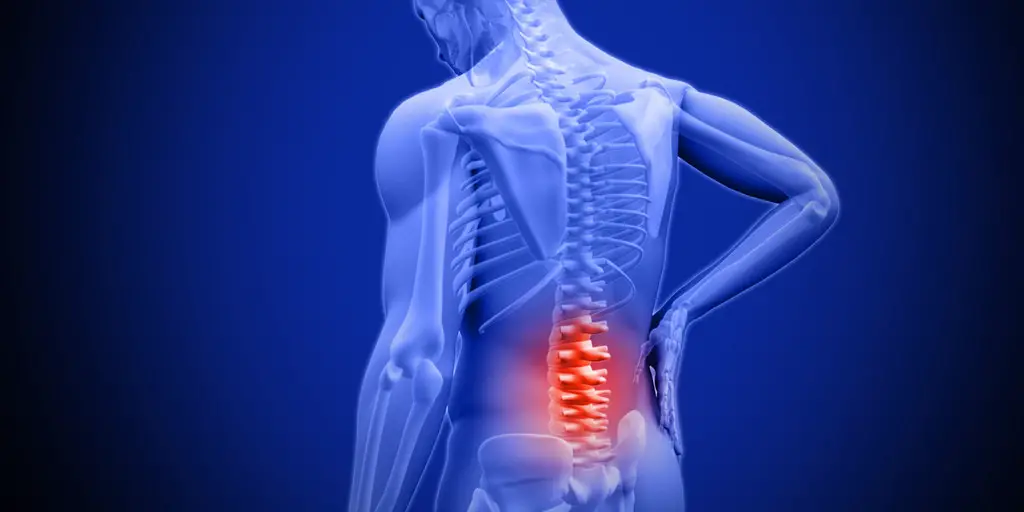Article reviewed and approved by Dr. Ibtissama Boukas, physician specializing in family medicine
Lumbar osteoarthritis is a common cause of back pain. Contrary to what one might think, it does not only affect the elderly.
What is osteoarthritis and what are the symptoms? What are the consequences on work and activities? Will activities like walking make it worse or relieve it?
This popular article explains everything you need to know about lumbar osteoarthritis, from the anatomy to the various possible treatments.
Definition and anatomy
Before discussing lumbar osteoarthritis, it is worth reviewing certain notions of anatomy that will allow you to better understand this condition.
La spine is separated into vertebrae cervical, dorsal and lumbar. At the lumbar level, the 5 vertebrae are notably connected together by the intervertebral disc and facet joints.
Lumbar osteoarthritis occurs when the cartilage that protects the joints in the lower back wears down and cracks, irritating the nerves around the bones, as well as the nerve roots nearby.
The wear of the vertebral joints at the lumbar level causes a vertebral compaction over time, as well as the formation of bony prominences called osteophytes.
Osteoarthritis can affect anyone, but it is most common in women and people over 50. The risk factors for osteoarthritis are mainly genetics, but also other factors such as a sedentary lifestyle or being overweight.
Little snag.
It is essential to mention that joint degeneration is part of normal aging, and is not always synonymous with disease.
Indeed, the presence of lumbar osteoarthritis has been observed in several people who have no back pain. This is because the body has adapted to the degenerative changes, and osteoarthritis does not cause inflammation or significant nerve irritation.
On the other hand, in some cases, the process of degeneration is problematic, and leads to significant disorders affecting the quality of life. It is in these situations that lumbar osteoarthritis requires medical care.
Causes of lumbar osteoarthritis: Where does it come from?
Few people know this, but osteoarthritis is a form of arthritis. It is also called osteoarthritis.
Besides osteoarthritis, there are other forms of arthritis and conditions that can affect the lumbar spine and its surroundings:
• Ankylosing spondylitis
• Psoriatic arthritis
• Enteropathic arthritis
• Osteoporosis
Symptoms: Lumbar osteoarthritis and its consequences
How to recognize lumbar osteoarthritis? Before going through themedical imaging, sufferers observe the consequences of this pathology through the following symptoms:
• Lower back pain. This is the most important symptom. In typical cases, it is increased in extension and reduced in flexion.
• Radiation of pain in the lower limbs, sometimes associated with numbness, tingling and sensation of electric shock.
• Pain on exertion, reduced by rest (except in advanced cases)
• Morning stiffness
• Muscle tension and spasms
• Reductions in range of motion of the lumbar spine
• Possible crackling, crackling or other noises in the lower back
• Feeling of weakness and/or general fatigue
Link between lumbar osteoarthritis and tingling?
Any injury to the lower back can irritate the nerve roots that originate from the spine and provide nerve conduction to the foot. As these nerves are responsible for providing sensation to the lower extremities, irritation at this level can cause tingling in the lower extremity.
Depending on the irritated spinal nerve, tingling will be felt in different places. A dermatome is an area of skin (skin) innervated by fibers from the same nerve root. It is therefore understood that an irration of a nerve (L1, L2, L3, L4, L5, S1) will cause an alteration of sensitivity according to a precise topography.
If the tingling affects both lower limbs, one can either suspect nerve damage on both sides of the lumbar spine, or an impairment of the spinal cord qualified as myelopathy. The latter is sometimes found in the presence of narrow lumbar canal. This is a serious condition, and requires urgent medical intervention.
Link between lumbar osteoarthritis and fatigue
In the lumbar spine, osteoarthritis can lead to the development of spurs bony, which can narrow the spaces between the vertebrae and put pressure on the spinal cord.
In addition, osteoarthritis can cause cartilage degradation which cushions the joints, leading to pain and stiffness. Fatigue is a common symptom of osteoarthritis, and it can have a big impact on quality of life.
Fatigue is often a consequence of inflammation leading to the pain and reduction de the activity physical. Furthermore, the fatigue maybe a swerve secondary of medications used to treat osteoarthritis.
Why is lumbar osteoarthritis painful at night?
It is not uncommon for patients with lumbar osteoarthritis to complain of pain at night. Here are several potential reasons for this phenomenon:
- Lying down can be uncomfortable and irritate the vertebrae in some individuals.
- The poor quality of the mattress can be responsible for pain
- The static position during sleep increases muscle and joint stiffness, hence the aggravated pain on waking
- Although there is no scientific evidence, it is possible that the temperature of the room and the level of ambient humidity influence osteoarthritis-type pain.
- During the night, the attention can be focused more on the pain, unlike during the day when daily activities keep us busy.
- If you are taking medication, the analgesic effect may wear off overnight, causing an increase in symptoms.
Diagnosis of lumbar osteoarthritis
As mentioned, the causes of lumbar osteoarthritis are multiple.
A doctor will begin the consultation with questions aimed at better understanding your medical history, injury history, symptoms and functional impact.
Then, he will perform a clinical examination where he will observe the movements of your spine, muscle strength, reflexes and other neurological tests.
To clarify the diagnosis, it is not uncommon for it to refer to a medical imaging. Among the tests used are:
• X-ray (to observe the space between your vertebrae)
• To scan
• MRI (to observe soft tissue and nerve integrity)
• Bone densitometry (to determine if osteoporosis is present)
Finally, a blood test may be requested if the doctor suspects systemic involvement or an inflammatory condition.
Treatment: How to relieve lumbar osteoarthritis
Lumbar osteoarthritis should not be synonymous with condemnation. Certainly, it is almost impossible to act on the degeneration, if not via the operation.
On the other hand, there are many modalities aimed at relieving the pain and functional limitations induced by lumbar osteoarthritis:
heat and ice
Heat and ice can help relieve symptoms by reducing inflammation and muscle spasms often associated with osteoarthritis. On the other hand, they do not act directly on the cause of the problem.
To learn more about using heat and ice, see next article.
Massage and manual therapy
A trained therapist (such as an osteo or physiotherapist) can relieve symptoms by performing manual techniques.
Massages can reduce muscle tension. Mobilizations and manipulations can reduce stress on the vertebrae, or increase the range of motion in the lumbar region.
Weight control
Overweight and obesity have been related to back pain, although the relationship is not proportional.
So, by maintaining a healthy weight (meaning shedding our extra pounds if that's the case), we can reduce the pressure on the joints and potentially see an improvement in symptoms.
A anti-inflammatory diet can for example make it possible to fight inflammation while losing weight, assuming that a calorie deficit is respected.
Exercices
Physical exercise has several health benefits. Applied in a specific and gradual manner, it can help reduce the symptoms of lumbar osteoarthritis over the long term, and facilitate the resumption of daily activities.
Un physiotherapist (physiotherapist) is best able to provide an exercise program adapted to your condition. Often, this will include sheathing, strengthening of the lower back and hips, mobility, etc.
Lumbar osteoarthritis and walking
Many people with lumbar osteoarthritis wonder if walking is allowed, or if it would aggravate the symptoms.
In general, walking is a cardiovascular activity with several benefits for the joints, the heart and overall health.
More specifically, walking has the following benefits:
Walking promotes cartilage nutrition and mobility
Walking activates blood circulation and optimizes the production of synovial substance. The joints and lumbar vertebrae are then better nourished and better lubricated, which would optimize mobility.
Walking improves flexibility and corrects posture
Trying to remedy gait problems with light exercises contributes to the gradual elimination of stiffness and mobility limitations.
Walking strengthens the musculoskeletal system
Walking strengthens the muscles, bones and tendons in the back for better support. There will therefore be an improvement in the assimilation of traumas and shocks liable to damage the joints. Their wear is then slowed down, or even avoided.
Walking is also effective against pain
Since the nutrition of the cartilages is improved, the effects of wear, in particular pain, will be reduced.
Walking promotes independence
You will no longer need to depend on the help of others to walk. This optimizes self-esteem, in addition to releasing hormones (endorphins) promoting well-being.
In the presence of osteoarthritis, permission to walk will depend on the symptoms caused. If walking causes significant pain from the outset, it will either have to be avoided or the parameters adjusted. In general, this occurs when osteoarthritis is in an advanced stage.
Consider this: If walking causes pain, you can try the following adaptations:
• Reduce walking speed by walking more slowly
•Reduce the distance by taking regular breaks
• Change the walking surface (on grass or a running track)
• Wear walking shoes with support
• Take medication or apply heat beforehand to facilitate walking.
• Apply ice after walking sessions
• Practice exercises of diaphragmatic breathing during walking to facilitate blood circulation and tissue oxygenation.
• Practice meditation techniques (such as mindfulness meditation) during walking to modulate symptoms.
• Practice dynamic stretching before the walking session
As you have seen, there are several solutions to try before definitively stopping walking – despite the incapacitating pain.
Natural products and alternative medicine
Although they are not supported by quality scientific studies, many people are turning to alternative approaches to relieve their lumbar osteoarthritis.
Among the methods tried are:
- Acupuncture
- acupressure mat
- Cupping (suction cups)
- Hypnotherapy
- Glucosamine and chondroitin
- Vitamin D
- Etc
Natural anti-osteoarthritis food supplements
The dietary supplement based on turmeric is a powerful anti-inflammatory. It helps to reduce painful inflammations and also delays theevolution of lumbar osteoarthritis.
La Devil's claw (Intergovernmental Panel on Climate Change) and the harpagophytum has anti-inflammatory and analgesic properties. Taken in the form of a food supplement, it helps the body to fight considerably against pain and other symptoms related to lumbar osteoarthritis.
The dietary supplement based on memories of Cassis fruit is both anti-inflammatory, antioxidant and diuretic. It thus acts at the same time against joint pain and the premature aging of cells. The use of this supplement also contributes to the elimination of toxins which aggravate the symptoms.
In case of osteoarthritis, it is important to use food supplements rich in zinc, calcium et vitamin C. These strengthen and help the body to better fight against lumbar osteoarthritis.
La glucosamine and chondroitin are substances often recommended to relieve osteoarthritis of the lower back. It allows the regeneration of damaged cartilage.
Le organic silicon, resveratrol (red grapes and berries), the pycnogenol (maritime pine bark), the bosxellia serrata, linen, glucosamines are also allies against osteoarthritis.
The ideal essential oils in case of lumbar osteoarthritis
Some essential oils are involved in the natural treatment for osteoarthritis thanks to their many properties. Used in massage, they must be diluted with vegetable oils which have anti-inflammatory molecules. Here are some of the most effective.
- Wintergreen essential oil: it has an effect similar to aspirin. It is a powerful anti-inflammatory. In case of lumbar osteoarthritis, it quickly relieves joint pain.
- Lemon eucalyptus essential oil: it contains active substances that give it an anti-inflammatory and painkiller effect. The use of this natural product thus makes it possible to relieve the pain associated with osteoarthritis in a less aggressive way than medication.
- Camphor rosemary: it is often mentioned when talking about osteoarthritis. The essential oil from this plant is a real ally against lumbar osteoarthritis.
- Peppermint essential oils as well as fine lavender: they are also often recommended in cases of osteoarthritis thanks to their anti-inflammatory, painkiller and analgesic properties.
Infiltration
In cases where conservative treatments do not offer conclusive results, the doctor usually resorts to more invasive treatments.
Lumbar infiltration can be used to relieve pain and calm inflammation. To learn more (as well as what type of infiltration to consider), check out next article.
surgery
The last resort is to resort to lumbar surgery. An orthopedic surgeon is the most qualified to determine the appropriateness of surgery, as well as the type of operation offering the best chance of recovery.
The most common operation islumbar arthrodesis. If lumbar osteoarthritis is accompanied by herniated disc symptomatic, he may also have resorted to a laminectomies or an discectomy.
How to sleep better at night in the presence of lumbar osteoarthritis?
As sleep is very important for optimal healing, it is important to find strategies to sleep better at night. A health professional will be able to help you determine the cause of your lack of sleep, and find remedies adapted to your situation.
In the meantime, here are some avenues to explore to relieve your symptoms and improve your quality of sleep:
Breathing and meditation
In the presence of pain, it is possible to modulate the symptoms by practicing breathing techniques or meditation.
For example, the diaphragmatic breathing will have the effect of improving circulation and oxygenation of the body, in addition to desensitizing the nervous system.
La mindfulness meditation (Mindfullness in English), meanwhile, will reduce pain by inducing an environment conducive to relaxation and well-being.
Adequate sleeping position
Poor sleep quality can be attributed to improper posture. In the presence of symptomatic lumbar osteoarthritis, it is preferable to optimize one's position in bed to increase comfort during the night.
The use of a knee cushion, for example, helps support the lumbar region, as well as avoiding lumbar twists or other awkward positions.
To learn more about the sleeping positions to be preferred in the presence of low back pain, see the following article.
Mattress
If you wake up in the morning with a lot of pain despite using proper posture, your mattress may be contributing to your pain. And even more if the aggravation of your back pain coincides with a change in your mattress, or a stay away from the comfort of your bed.
How to choose the right mattress? Of course, each person is different and may prefer a certain type of mattress. Some studies have shown that there is a type of mattress associated with less lower back pain upon waking, and less disability. Contrary to popular belief, it is not the soft mattress, nor the firm, but the semi-firm.
Can we work with lumbar osteoarthritis?
It was found that the symptoms of lumbar osteoarthritis varied enormously depending on the individual. Sometimes asymptomatic in some cases, it can also cause disabling and limiting pain in some people.
The question of work in the presence of lumbar osteoarthritis should be discussed individually with his doctor. First, you will have to see if your symptoms are a hindrance to the practice of your professional activities.
Then, you will have to analyze the physical demands of your job, and determine if you are able to exercise your profession. A sedentary job is much easier to perform than a job involving the carrying of heavy loads when you suffer from low back pain.
Disability rate for lumbar osteoarthritis
The other frequently asked question is related to the disability rate for lumbar osteoarthritis.
A disease is said to be occupational if it results from direct exposure to a physical, chemical or biological risk. It must also result from the conditions in which a worker exercises his professional activity, and must appear in one of the tables of the general or agricultural Social Security system.
The tables of occupational diseases 97 and 98 relate to back pain, and define a number of criteria which must all be met to allow recognition of the disease.
Here are the conditions that must be met for back pain to be recognized as an occupational disease:
- It must be a chronic condition (defined by a duration of at least 3 months)
- If the pain radiates into the leg: the sciatica or radiculalgia femoral crural must be caused by a herniated disc with a topography consistent with the root involvement. For sciatica, the herniated disc must be level L4-L5 or L5-S1. For crural radiculalgia, the herniated disc must be level L2-L3, or L3-L4, or L4-L5.
- The herniated disc must be explicitly qualified in the report of the radiological examination via a scanner or MRI.
- The duration of exposure to the risk is 5 years, and the period of coverage must be a maximum of 6 months.
It can therefore be seen that at present, lumbar osteoarthritis alone does not meet the above criteria, and therefore cannot be recognized as an occupational disease.
On the other hand, if you really think that your condition results from your professional activity, it is possible to make a declaration of illness called excluding tables.
In accordance with law 93-121 of July 27, 1993, a disease not mentioned in a table can be recognized as being occupational:
- if it is directly attributable to the professional activity of the victim.
- and if it results in incapacity for work of at least 25%.
Conclusion
Lumbar osteoarthritis is due to the degeneration of the joints in the lumbar region. It may be the cause of your lower back pain.
To be sure, it is advisable to consult a doctor who will carry out a clinical examination, and will refer to medical imaging examinations if necessary.
Once the diagnosis is made, it will be possible to establish a treatment plan taking into consideration your medical history, your symptoms, and your goals.
Good recovery !





